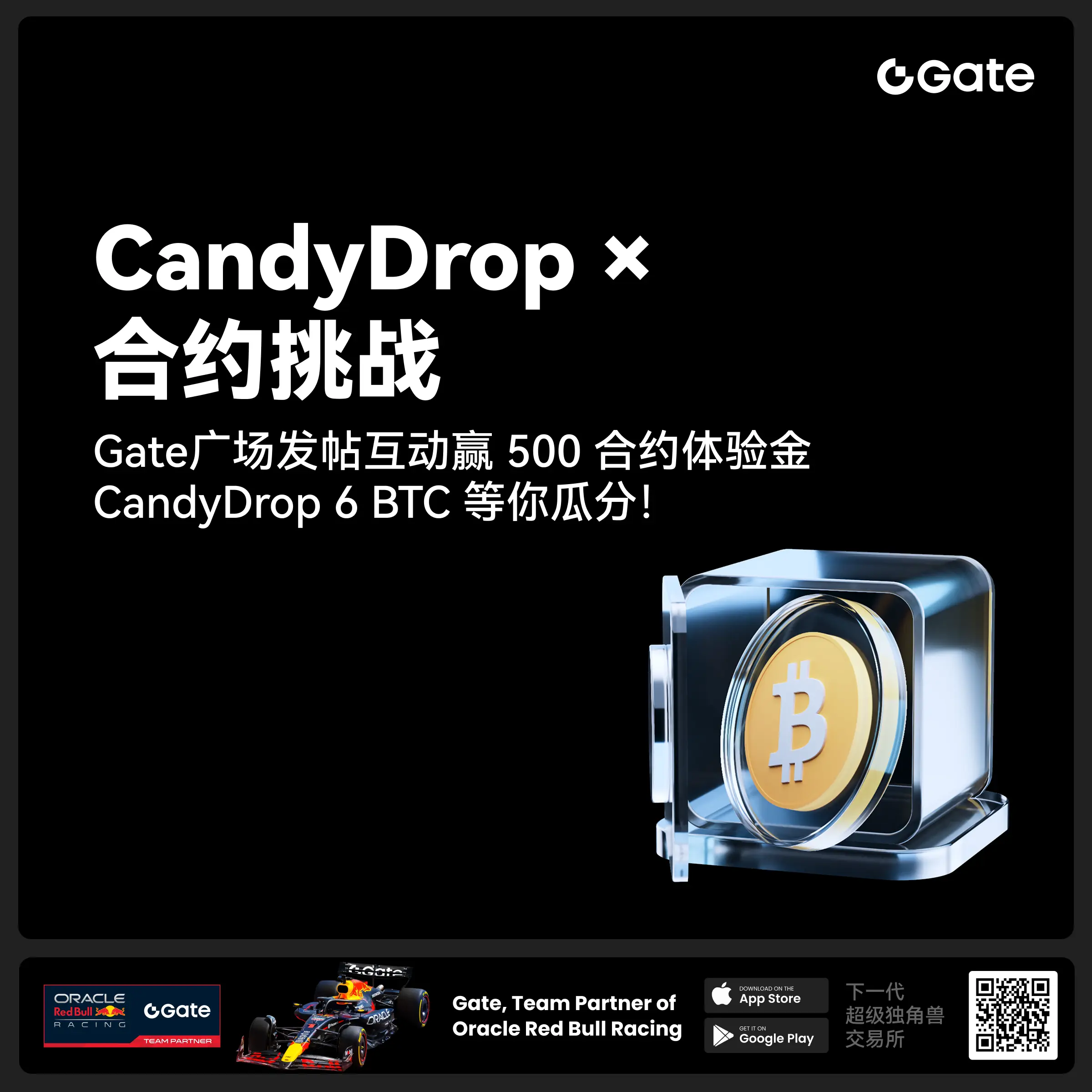- 话题1/3
67k 热度
47k 热度
61k 热度
9k 热度
23k 热度
- 置顶
- 🎉 #CandyDrop合约挑战# 正式开启!参与即可瓜分 6 BTC 豪华奖池!
📢 在 Gate 广场带话题发布你的合约体验
🎁 优质贴文用户瓜分$500 合约体验金券,20位名额等你上榜!
📅 活动时间:2025 年 8 月 1 日 15:00 - 8 月 15 日 19:00 (UTC+8)
👉 活动链接:https://www.gate.com/candy-drop/detail/BTC-98
敢合约,敢盈利
- 🎉 攒成长值,抽华为Mate三折叠!广场第 1️⃣ 2️⃣ 期夏季成长值抽奖大狂欢开启!
总奖池超 $10,000+,华为Mate三折叠手机、F1红牛赛车模型、Gate限量周边、热门代币等你来抽!
立即抽奖 👉 https://www.gate.com/activities/pointprize?now_period=12
如何快速赚成长值?
1️⃣ 进入【广场】,点击头像旁标识进入【社区中心】
2️⃣ 完成发帖、评论、点赞、发言等日常任务,成长值拿不停
100%有奖,抽到赚到,大奖等你抱走,赶紧试试手气!
截止于 8月9日 24:00 (UTC+8)
详情: https://www.gate.com/announcements/article/46384
#成长值抽奖12期开启#
- 📢 Gate广场 #NERO发帖挑战# 秀观点赢大奖活动火热开启!
Gate NERO生态周来袭!发帖秀出NERO项目洞察和活动实用攻略,瓜分30,000NERO!
💰️ 15位优质发帖用户 * 2,000枚NERO每人
如何参与:
1️⃣ 调研NERO项目
对NERO的基本面、社区治理、发展目标、代币经济模型等方面进行研究,分享你对项目的深度研究。
2️⃣ 参与并分享真实体验
参与NERO生态周相关活动,并晒出你的参与截图、收益图或实用教程。可以是收益展示、简明易懂的新手攻略、小窍门,也可以是行情点位分析,内容详实优先。
3️⃣ 鼓励带新互动
如果你的帖子吸引到他人参与活动,或者有好友评论“已参与/已交易”,将大幅提升你的获奖概率!
NERO热门活动(帖文需附以下活动链接):
NERO Chain (NERO) 生态周:Gate 已上线 NERO 现货交易,为回馈平台用户,HODLer Airdrop、Launchpool、CandyDrop、余币宝已上线 NERO,邀您体验。参与攻略见公告:https://www.gate.com/announcements/article/46284
高质量帖子Tips:
教程越详细、图片越直观、互动量越高,获奖几率越大!
市场见解独到、真实参与经历、有带新互动者,评选将优先考虑。
帖子需原创,字数不少于250字,且需获得至少3条有效互动
- 🎉 亲爱的广场小伙伴们,福利不停,精彩不断!目前广场上这些热门发帖赢奖活动火热进行中,发帖越多,奖励越多,快来GET你的专属好礼吧!🚀
1️⃣ #GateLaunchpad上线IKA# |IKA认购体验
在Gate广场带话题晒出你的IKA Launchpad认购体验,4位幸运分享者讲瓜分$200分享奖池!
详情 👉️ https://www.gate.com/post/status/12566958
2️⃣ #ETH冲击4800# |行情分析预测
大胆发帖预测ETH走势,展示你的市场洞察力!10位幸运用户将平分0.1 ETH 奖励!
详情 👉️ https://www.gate.com/post/status/12322403
3️⃣ #创作者活动第二期# |ZKWASM话题
在广场或推特发布与 ZKWASM 或其交易活动相关的原创内容,瓜分4,000枚ZKWASM!
详情 👉️ https://www.gate.com/post/status/12525794
4️⃣ #Gate广场征文活动第二期# |ERA话题
谈谈你对ERA的观点/体验,参与并推广活动,700 ERA大奖等你赢!
详情 👉️ https://www.gate.com/post/status/12361653
5️⃣ #MBG任务挑战# |MBG话题
分享你对MBG的洞察,积极参与和推广MBG活动,20位小
What are Eth_ions and how they work compared to Bitcoin Ordinals
Despite its relatively recent launch, Ethions has shown tremendous acceptance, evoking parallels with Bitcoin’s Ordinals.
The Ethereum (ETH) community, known for its unrelenting pursuit of experimentation and innovation, has a new brainchild—Ethions
Ethions is the latest protocol stirring interest in the Ethereum community. It leverages Ethereum’s calldata to enable users to inscribe non-financial data directly onto the Ethereum main chain.
Developed by Tom Lehman, co-founder of Genius.com, Ethions offers a more decentralized and economical approach than the conventional contract storage method
By leveraging Ethereum’s calldata, Ethions allows users to inscribe non-financial data under 96 kilobytes in size, primarily images at present, directly onto the Ethereum main chain.
It’s the literary equivalent of etching a message in stone—a message that will remain etched in the vast digital landscape of Ethereum.
With an overwhelming response from the community, close to 30,000 Ethions were created within 18 hours of the protocol’s launch. This dynamic debut echoes the launch of Ordinals on Bitcoin, marking another pivotal moment in the blockchain world.
Ethions vs. Ordinals: a tale of two protocols
Bitcoin’s (BTC) Ordinals and Ethereum’s Ethions were born from a shared vision: to expand blockchain beyond mere financial transactions
While Ordinals marked the Bitcoin network’s foray into the world of non-financial data inions, Ethions, albeit similar, bring a fresh perspective to the Ethereum network.
You might also like:
Bitcoin Ordinals upgrade addresses ‘cursed inions’ issue While both protocols reflect innovation, the community’s response is a stark difference. The introduction of Ordinals faced pushback from some Bitcoin maximalists, resistant to deviating from Bitcoin’s primary function as a financial asset.
On the other hand, the Ethereum community embraced Ethions with open arms. Ethereum’s culture of innovation and experimentation could explain this acceptance, as it has always positioned itself as a ‘world computer’ and a platform for decentralized applications (dApps) rather than just a currency.
Ordinals and Ethions use different methods to inscribe data. Ordinals rely on Bitcoin’s transaction data, whereas Ethions leverages Ethereum’s “calldata.”
Ethereum’s approach is seen as more decentralized and cost-effective than using contract storage, a significant point of difference.
Ordinals allow ious inions, including artwork, profile pictures, and playable games. Ethions, although currently limited to image-only inions, intends to expand to accommodate different file types, potentially leading to broader applications.
A notable implication of both protocols is the potential rise in transaction costs. Bitcoin saw an increase in transaction fees with the advent of Ordinals, a likely scenario for Ethereum with Ethions, especially given Ethereum’s already high transaction fees
The community response and potential implications
An undeniable indicator of the community’s excitement about this groundbreaking venture is the launch of Ethereum Punks, a collection of non-contract punks similar to those on the Bitcoin network. All 10,000 inions were claimed almost immediately post-launch
However, this high activity level resulted in occasional downtime and necessitated Lehman’s assurances to the community about the project’s technical stability.
Ethereum’s innovation doesn’t come without implications. The launch of Ethions could result in an upswing in Ethereum’s transaction fees
But do not let this dissuade you. Increased transaction fees incentivize miners to sustain their efforts, ultimately fortifying the security of the decentralized platforms
This measure is crucial, considering Ethereum tops the chart as the most expensive chain for transactions and development.
Future of Ethions
The narrative of Ethions may have just begun, but its potential ramifications are colossal. Users can only inscribe images, but Lehman hints at a future where different file types could be uploaded
The widespread acceptance of Ethions illuminates the continued push for innovation and the endless quest for improved functionalities within the blockchain universe.
While some argue that similar technologies have existed for years, Ethions’ swift adoption and awareness underline a newfound appreciation for such initiatives
Whether Ethions will continue to make waves or become a transient ripple in the blockchain pond depends on the ongoing community engagement and adoption
For now, Ethereum’s innovative spirit remains undeterred, continuously seeking new territories to explore in the expansive universe of blockchain.
Read more:
What happened to Celsius Network: a year in review